What is the respective ratio of the numbers of candidates failing in the exam from city D to those failing in the exam from city A?
The correct Answer is:=227:50
To find the respective ratio of the number of candidates failing in the exam from city D to those failing in the exam from city A, we can follow these steps:
1. Identify the Number of Candidates Failing in City D (CTD):
- From the data table, let's assume the total number of candidates from City D is given as 2.27 (this might be in thousands or any unit).
- The number of candidates failing in City D can be calculated using the formula provided in the transcript:
Failing Candidates in CTD=2.27×33+1
- Simplifying this:
Failing Candidates in CTD=2.27×34=6.814=1.7025
2. Identify the Number of Candidates Failing in City A (CTA):
- Similarly, from the data table, let’s assume the total number of candidates from City A is 1.25.
- The number of candidates failing in City A can be calculated as:
Failing Candidates in CTA=1.25×33+7
- Simplifying this:
Failing Candidates in CTA=1.25×310=3.7510=0.375
3. Calculate the Ratio of Failing Candidates:
- Now, we need to find the ratio of failing candidates from City D to City A:
Ratio=Failing Candidates in CTDFailing Candidates in CTA=1.70250.375
- To simplify this ratio, we can multiply both the numerator and denominator by 1000 to eliminate the decimal:
Ratio=1702.5375
- Dividing both numbers by 125 to simplify:
Ratio=1702.5÷125375÷125=13.623≈4.54
- To express this as a simple ratio, we can round it to the nearest whole number, giving us approximately:
Ratio=4.5:1 (or expressed as a fraction, 9:2)
Final Answer:
The respective ratio of the number of candidates failing in the exam from city D to those failing in the exam from city A is approximately 9:2.
- From the data table, let's assume the total number of candidates from City D is given as 2.27 (this might be in thousands or any unit).
- The number of candidates failing in City D can be calculated using the formula provided in the transcript:
Failing Candidates in CTD=2.27×33+1
- Simplifying this:
Failing Candidates in CTD=2.27×34=6.814=1.7025
- Similarly, from the data table, let’s assume the total number of candidates from City A is 1.25.
- The number of candidates failing in City A can be calculated as:
Failing Candidates in CTA=1.25×33+7
- Simplifying this:
Failing Candidates in CTA=1.25×310=3.7510=0.375
- Now, we need to find the ratio of failing candidates from City D to City A:
Ratio=Failing Candidates in CTDFailing Candidates in CTA=1.70250.375
- To simplify this ratio, we can multiply both the numerator and denominator by 1000 to eliminate the decimal:
Ratio=1702.5375
- Dividing both numbers by 125 to simplify:
Ratio=1702.5÷125375÷125=13.623≈4.54
- To express this as a simple ratio, we can round it to the nearest whole number, giving us approximately:
Ratio=4.5:1 (or expressed as a fraction, 9:2)
The respective ratio of the number of candidates failing in the exam from city D to those failing in the exam from city A is approximately 9:2.
Topper's Solved these Questions
- DATA TABLE BOOK - ARIHANT SSCCHAPTER - DATA TABLE EXERCISE - EXERCISE BASE LEVEL QUESTIONS
54 Videos
- DATA TABLE BOOK - ARIHANT SSCCHAPTER - DATA TABLE EXERCISE - HIGHER SKILL LEVEL QUESTIONS
25 Videos
- DATA SUFFICIENCYBOOK - ARIHANT SSCCHAPTER - DATA SUFFICIENCYEXERCISE - FAST TRACK PRACTICE
30 Videos
- DISCOUNTBOOK - ARIHANT SSCCHAPTER - DISCOUNTEXERCISE - FAST TRACK PRACTICE
47 Videos
Similar Questions
Directions (Questions 16 to 20): Study the following table carefully and answer the questions that follow: Number of Candidates (in lakhs) Appearing In an Entrance Examination From Six Different Cities City A B C D E F Number of candidates 1.25 3.14 1.08 2.27 1.85 2.73 Ratio of Candidates Passing And Failing Within the City City Ratio of Passing and Failing A 7 : 3 B 5 : 3 C 4 : 5 D 1 : 3 E 3 : 2 F 7 : 5 What is the ratio of the number of candidates failing the exam from City D to that of those failing the exam from City A ? (a) 289 : 42 (b) 42 : 289 (c) 227 : 50 (d) 50 : 227 (e) None of these
View Solution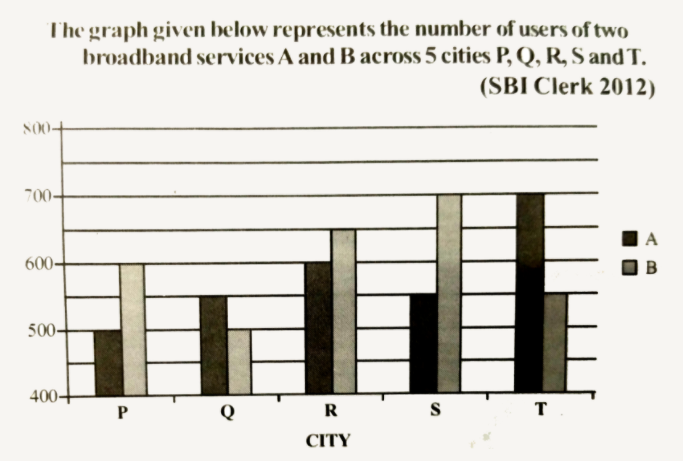
What is the respective ratio of the number of users of brand A in city P to the number of users of brand B in city S ?
View Solution
Knowledge Check
What is the respective ratio of total number of candidates clearing the entrance exam from stateB in the year 2004 to those clearing the entrance exam from state C in the same year?
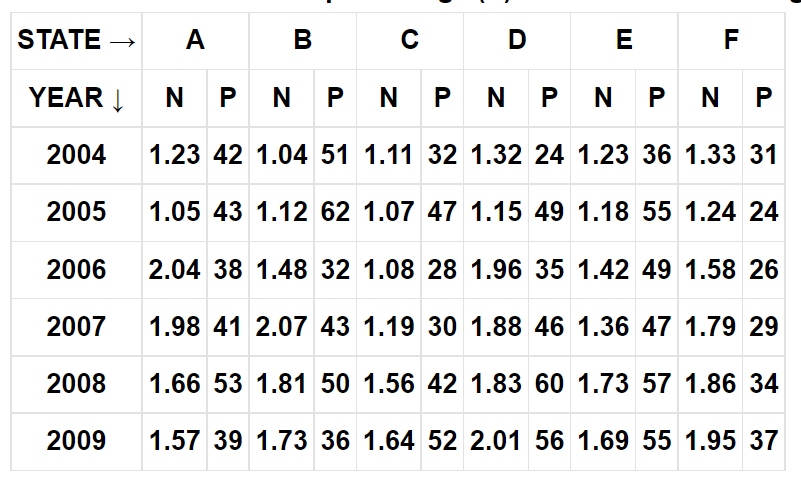 A221:148B218:143C148:221D143:218
A221:148B218:143C148:221D143:218Study the following graph and answer the questions that follows:-
Number of appeared candidates and passed Candidates (in hundreds) in a test from six different institutions.
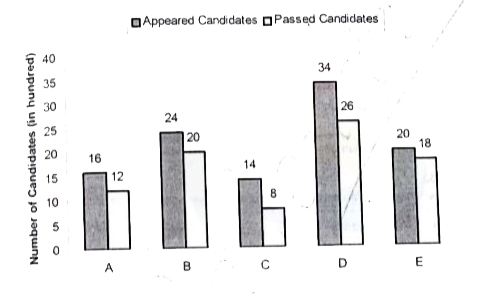
What is the respective ratio between the number of candidates who have failed from institution B and the number of candidates who have appeared from institutions E ?A3:7B1:3C1:5D3:4What is the total number of candidates clearing the entrance exam from states E and F together in the year 2006?
 A16160B110660C1.1066D1106600
A16160B110660C1.1066D1106600
What was the respective ratio between the number of candidates who appeared from school -C in the year 2006 and the number of candidate who passed in the exam from school - D in the year 2009 ?
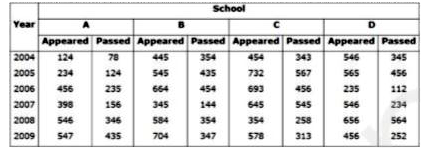
View SolutionThe number of candidates appearing for the exam from city C is what percent of the number of candidates appearing for the exam from city B?
View SolutionThe number of candidates appearing for the exam from City C is what per cent of the number of candidates appearing for the exam from City B ? (rounded off to nearest integer) (a) 27% (b) 34% (c) 42% (d) 21% (e) 38%
View SolutionWhat is the number of unsuccessful candidates in city D?
View SolutionStudy the following table and answer question.
Number of students appeared in an examination from five cities :
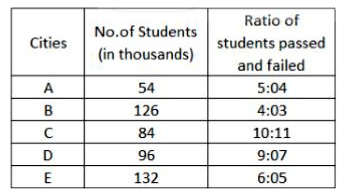
The ratio of the total number of students passed in the examination from cities A and D to that of students failed from cities B and E ?
View Solution
